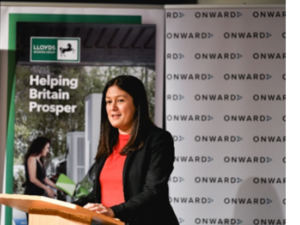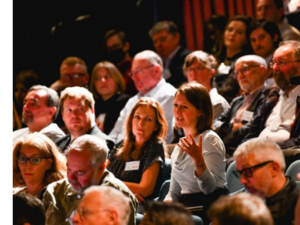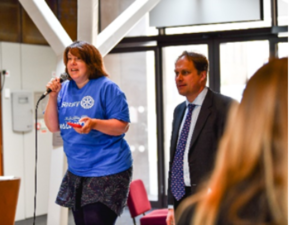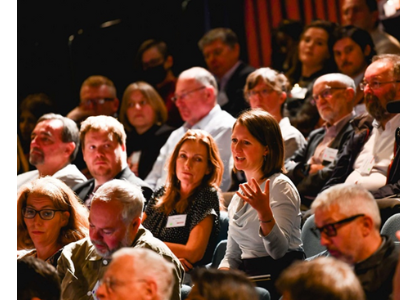Create Streets’ director, Nicholas Boys Smith, reflects on our recent Restitch summit

A few weeks’ ago with our friends at Onward, we ran the Restitch Summit in London and Halifax. It came at a crucial time. Political debate is fractious and mistrustful. Social fabric is fraying. Connections to people and place that have evolved over centuries are unravelling. The summit raised many challenges of work and worth, place and mutual trust. We have not just forgotten the art of disagreeing well. For too many, as Michel Sandel reminded us, work has also lost dignity. Meritocracy has created too few winners and too many losers; “that’s the reality that has got lost in the rolling news.” As a society we have also lost the confidence that the man (and it usually was a man) in Whitehall or City Hall knows best.
There are many reasons. Economic changes have hollowed out towns and their civic institutions nationwide. The housing shortage has forced millions to live more precarious lives. The housing that does get built is too often ugly and disconnected from local communities, “units” not homes, estates not places. And the recent tech revolution, ostensibly enriching our connections, has nevertheless created an epidemic of loneliness, mistrust and intense ‘culture war’ conflict over discussions which can flare up from nothing to an intense firestorm of mutual recrimination over a lunch time.

As the delegates and speakers at Restitch Summit showed, one critical way to meet these problems in regeneration, planning and social policy is to relearn that ‘place’ matters, and that places must be allowed to shape their own future. People want to feel that where they live has intrinsic purpose and its own unique value within the national identity. Too many of our high streets are drab, uninteresting and unprosperous, hollowed out by ‘necessary investment’ in bland boxes or ring road business parks and the atomised lives they promote. We have become, as Lisa Nandy put it our summit, “catastrophically over reliant on a small number of industries and places” to drive economic and cultural growth.
There is much talk from all sides of the importance of ‘local communities.’ However, little effort is made to nurture them or the neighbourhoods that contain them. Doing so means focusing not just on good jobs, good infrastructure, and physical places for people to connect, but on more intangible things like love, purpose and beauty. Regeneration cannot just be technocratic. We should recognise that place is emotional as well as practical. All aspects of a place’s economic and human prosperity are inter-connected. Any one key action alone is highly unlikely to overcome deep-seated challenges. Instead, we should ask: what do we need to do to encourage many actions? What is the best place to start? What actions will increase a place’s ‘economics of attraction’, build confidence, encourage footfall, de-risk and encourage investment, support the wellbeing of existing residents and encourage new residents? What are the most important ‘anchor institutions’ -often good schools? Though the sequencing and relative focus of actions will vary place to place, a virtuous circle of regenerative change is likely to include steps to re-create a good place to live, work and raise children easy to be proud of and worth visiting such as:
- Access to purposeful work;
- A green place to live;
- A good and healthy place to live; with
- Good and affordable homes.
We need to set a clear vision which will encourage a virtuous circle of regenerative change to improve the liveability of a place and the prosperity of existing and new residents and jobs. We must make the case for better quality, more attractive buildings and places in which people can live, love and work. Too much of our built environment has become a mirror to our society – cold, faceless and intimidating.
Councils and major landowners should not think of “regeneration” and “place-making” as something that they do and start thinking of it as something that they enable. The most profound and long-lasting improvements to a place have many authors not one author. The role of the local council or major landowners is to catalyse, to create a framework in which it becomes lower risk, easy and natural for others as well as themselves to invest in a place, emotionally, practically and financially. Above all this is about reducing risk for third parties within a clear quality framework.
More widely, recent decades have seen smaller towns lose out to fast-growing cities as young people move away in search of better jobs. The COVID-19 pandemic, and the consequent rise in home-working, gives us a chance to re-set that trend, and revive neglected places. The moment is now. The window will close if we are not careful.

Balancing that tension between locality and mobility will be a key challenge, as will balancing the needs of different age groups. Avoiding tough conversations and culture war hot topics might seem the easiest route to communal harmony. But, in the long run, constructive engagement is the best way to arrive at consensus. The more people willing to step in and defuse the issues that divide us, the more common agreement we are likely to find.
The Restitch Summit was also a reminder that there is no single quick fix, no silver bullet that will solve all our societal problems. Politicians and community leaders should steer clear of grand solutions or sweeping redevelopments. The path to national renewal runs through the local pub, park and corner shop, on “the local and specific” as Rory Stewart put it. We should focus on putting together a critical mass of smaller changes to which we can all contribute, if we work together.
Low-key, immediate changes build confidence in local governance, and help convince people that their concerns are being listened to. They can range from planting street trees, improving cyclists’ and pedestrians’ access, or encouraging local businesses not just national chains. Studies show that community health can rise and fall on the basis of decisions that seem relatively trivial, such as the location of a new primary school. Schools should be in the heart of their neighbourhoods not sequestrated on the bypass – something we get wrong in nearly all new development.
Restitch also showed that community engagement is crucial. Devolution from central government should not stop at local councils but extend right down to resident associations and other local groups. However, we struggle to empower and enfranchise neighbourhood groups making funding or planning applications for whom, as one of our restitchers memorably said, engaging with officialdom is akin to “shooting arrows into the abyss of the funding system.”
Simplifying that system, and making it more accessible, will lead to more developments that local communities actually want, rather than be left feeling that development has been forced upon them. This is an opportunity to use technology and social media for good. Councils and community groups can use online survey platforms (including our own – Create Communities) quickly, effectively and cheaply to gauge local opinion and generate preferences.

Greater devolution and more community engagement will encourage us all to become ‘restitchers’. To play our part in building the critical mass of solutions. That is the challenge that the Restitch Summit set attendees – to take the ideas discussed at the summit and apply them to their local communities. So here is a challenge and a promise:
The challenge: what actions can you take to restitch your neighbourhood or professional, personal or local community? Please do let Create Streets and Onward know by sharing on social media under the #RestitchAction hashtag. We will also publish an update on this in about six months and will be getting back to conference attendees before then.
The promise: as we collectively and individually develop this agenda and our publications and research in this area, Create Streets and Onward will be running another summit in 12-18 months. This may be the start of something. Watch this space for more…
With thanks to Michael Milner-Watt for research and drafting


